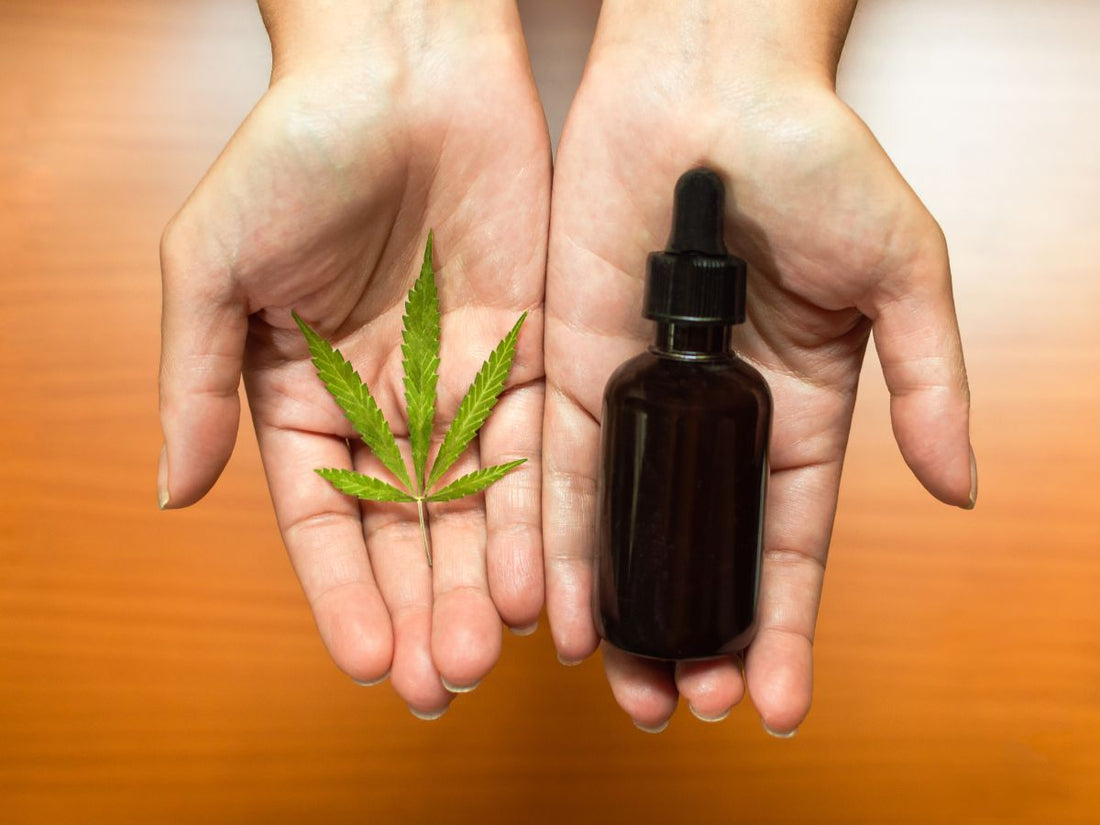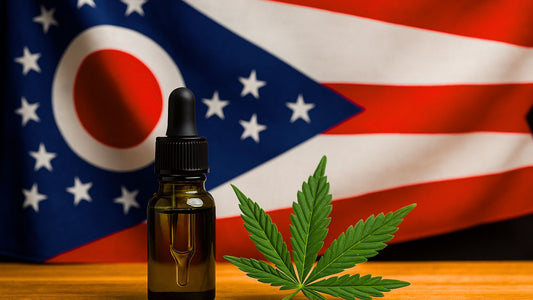CBN, CBD, and THC are three of over 113 cannabinoids found in the hemp plant. CBN is a minor cannabinoid compared to CBD and THC and has not been studied as extensively as CBD.
New research shows that Cannabinol may have a lot of potential benefits of its own.
All 3 cannabinoids have different chemical structures, effects, and benefits.
In this article, we will explore:
- what CBD, CBN and THC are
- how they interact with the endocannabinoid system
- how they interact with each other
- what are their benefits and uses, what are their side effects
- how they compare with each other.
What Are Cannabinoids?
Cannabinoids are natural chemicals that can attach to receptors in our body's endocannabinoid system (ECS).
This system regulates sleep, pain, stress, and overall health and well-being.
They act as messengers between cells and bind to cannabinoid receptors on the surface of cells.
There are two main types of cannabinoid receptors: CB1 and CB2.
CB1 receptors are mostly found in the brain and nervous system, while CB2 receptors are mostly found in the immune system and peripheral tissues.
The two most abundant endocannabinoids in the body are anandamide and 2-AG. Endocannabinoids help maintain a state of balance or homeostasis in the body, by regulating mood, memory, pain, inflammation, appetite, sleep, stress, immune response, and more.
There are two types of cannabinoids:
- Endocannabinoids: Endocannabinoids are cannabinoids that are produced by the body itself. They act as messengers between cells and bind to cannabinoid receptors on the surface of cells.
- Phytocannabinoids: Phytocannabinoids are cannabinoids that are produced by plants, especially the cannabis plant. The most well-known phytocannabinoids are THC and CBD, which have different effects and benefits.
What are CBN, CBD and THC - How are they similar?
CBN (cannabinol) and CBD (cannabidiol) and THC (tetrahydrocannabinol) are natural compounds derived from the cannabis plant. They belong to a group of chemicals called cannabinoids, which can affect the body and mind in various ways.
CBN and CBD are similar in some aspects.
For example, they both have potential anti-inflammatory, antioxidant, and neuroprotective properties. They both can modulate the activity of certain receptors and enzymes in the endocannabinoid system.
However, CBN and CBD also have some significant differences.
CBN is a byproduct of THC (tetrahydrocannabinol), the main psychoactive component of cannabis. CBN is formed when THC is exposed to heat, light, or oxygen over time.
CBD, on the other hand, is not derived from THC, but from another cannabinoid called CBDA (cannabidiolic acid). CBD is not psychoactive at all, while CBN is mildly psychoactive, even that is rare.
CBN's sedative effects are better described as calming rather than psychoactive, according to some studies.
A general consensus is that CBN is calming and sometimes mildly sedating, with no mind-altering effects as THC.
Another difference between CBN and CBD is their availability and legality. CBN is much rarer than CBD, as it only occurs in small amounts in aged or oxidized cannabis plants.
CBD is more abundant and widely available in the market.
CBN is also more expensive than CBD, as it requires more processing and extraction methods.
What’s the endocannabinoid system, and what does it do?
The endocannabinoid system (ECS) is a complex network of receptors, enzymes, and molecules that regulate various physiological and psychological processes in your body.
The ECS is involved in functions such as mood, memory, pain, appetite, sleep, and more.
The ECS consists of three main components: endocannabinoids, cannabinoid receptors, and metabolic enzymes. The body makes endocannabinoids as messengers between cells. They bind to cannabinoid receptors on the surface of cells to trigger certain responses.
Cannabinoid receptors are proteins that can recognize and interact with certain substances called endocannabinoids or phytocannabinoids.
These substances include CBN or CBD. There are two main types of cannabinoid receptors: CB1 and CB2. CB1 receptors are mostly found in the brain and nervous system, while CB2 receptors are mostly found in the immune system and peripheral tissues.
Metabolic enzymes break down endocannabinoids or external cannabinoids once they've done their job.
The ECS works by maintaining a state of balance or homeostasis in the body. If something disturbs this balance, like stress or injury, the ECS makes more endocannabinoids to fix it.
Sometimes the ECS doesn't work well because of things like genetics or lifestyle choices.
Which is where phytocannabinoids come in, they have similar chemical structure to endocannabinoids and can support your ECS when your body isn't making enough endocannabinoids by itself.
This is where external cannabinoids (such as CBN or CBD) can help. By interacting with the ECS, they can enhance or inhibit its activity depending on the situation.
CBD: Benefits, effects, and uses

CBD is one of the most researched and popular cannabinoids in the market. It has many potential benefits for various health and wellness purposes.
What are the benefits and uses of CBD?
CBD has many properties that can help with inflammation, symptoms of anxiety, and pain. It can also protect the brain, fight discomfort and inflammation, and even combat sleeplessness.
It can also modulate the immune system, lower blood pressure, and improve skin health.
Some of the conditions that CBD can help with are:
- Anxiety related effects: CBD can reduce general anxiety and stress in various situations.
- Stress: CBD can have antidepressant effects in animal models of depression, such as the forced swim test or the tail suspension test. CBD can also enhance the effects of conventional antidepressants, such as selective serotonin reuptake inhibitors (SSRIs).
- Sleep: One of the functions of the endocannabinoid system is to regulate our sleep cycles. It does this by changing neurotransmitters using the CB1 and CB2 receptors.
- Pain relief: Many people are turning to CBD oil to ease pain and inflammation in muscles and joints. Cannabidiol can help with pain topically as a CBD lotion or Gel, and it can also help ease discomfort internally as an ingestible supplement.
- Neuroprotection: CBD has been found to have neuroprotective properties which may protect against neurodegeneration. It is important to remember that more research is required to understand the effects better.
CBD can also be used for general wellness purposes, such as improving mood, energy, focus, relaxation, and more.
CBD can also support the health of the endocannabinoid system by restoring its balance and function.
What are the effects of CBD?
CBD is generally well-tolerated and safe to use. It does not produce a high or alter the mind. It does not cause addiction or dependence. It does not interfere with most drugs or supplements.
However in rare circumstances, CBD may have some mild side effects in some people, such as:
- Dry mouth
- Drowsiness
- Fatigue
- Diarrhea
- Changes in appetite or weight
- Low blood pressure
- Dizziness
- Headache
These side effects are mostly dose-dependent and transient. They can be avoided or minimized by starting with a low dose and gradually increasing it until the desired effects are achieved.
They can also be alleviated by drinking plenty of water, eating well, resting well, and consulting a doctor if necessary.
CBD may also interact with some medications or supplements that are metabolized by the liver enzymes CYP3A4 or CYP2C19. These include:
- Antidepressants
- Antipsychotics
- Anticonvulsants
- Antibiotics
- Antifungals
- Antihistamines
- Anti-inflammatories
- Blood thinners
- Steroids
- Hormones
CBD may either increase or decrease the effects of these substances by inhibiting or inducing their metabolism. This may result in either increased toxicity or reduced efficacy.
Therefore, it is advisable to consult a doctor before using CBD if you are taking any of these medications or supplements.
CBN: Benefits, effects, and uses

CBN is a minor cannabinoid that's less known and less studied than CBD. However, it has some promising benefits and uses for your health.
What are the benefits and uses of CBN?
CBN has been shown to have anti-inflammatory, anti-bacterial, anti-fungal, antispasmodic, analgesic, neuroprotective, bone-stimulating properties. It can also modulate the immune system and lower body temperature.
Some of the conditions that CBN can help with are:
- Sleep disorders: CBN can induce sleepiness and improve sleep quality in people with insomnia or other sleep problems.
- Pain Management: Just like CBD, CBN can help with pain and inflammation by interacting with your ECS. Some studies found that CBN and CBD together might be even more effective than CBD alone for relief.
- Inflammation: CBN can ease inflammation inside the body by activating the cannabinoid receptors (CB2). Some studies suggest that CBN can fight against various bacteria and fungi that cause infections. However, more research is required.
- Bone health: CBN may potentially stimulate the growth of stem cells in the bone marrow, which can create new bone cells and promote bone formation.
- CBN may also help to generate collagen, which is a protein that provides structure and strength to the bones and connective tissues.
CBN can also be used for general wellness purposes, such as relaxing, calming, soothing, and more. CBN can also support the health of the endocannabinoid system by restoring its balance and function.
What are the effects of CBN?
CBN is generally well-tolerated and safe to use. It does not cause addiction or dependence. It does not interfere with most drugs or supplements. It does not show up on drug tests (unless it contains traces of THC).
However, CBN may have some mild side effects in some people, such as:
- Drowsiness
- Sedation
- Impaired memory
- Impaired coordination
- Dry mouth
- Red eyes
These side effects are usually dose-dependent and transient like CBD’s side effects
CBD vs. CBN: Side effects

CBD and CBN have similar side effects, such as drowsiness, dry mouth, low blood pressure, and changes in appetite or weight.
However, CBD is less likely to cause sedation than CBN which is often called the "bedtime cannabinoid".
CBD and CBN have different interactions with other substances. CBD may reduce the effects of THC by blocking its binding to CB1 receptors, while CBN may enhance the effects of THC by increasing its binding affinity to CB1 receptors.
CBD may also counteract some of the negative effects of THC, such as paranoia and anxiety, while CBN may not.
Can you mix CBD and CBN?
Yes, you can mix CBD and CBN to achieve a synergistic effect known as the entourage effect. Full-spectrum CBD products have all the cannabinoids including CBD, CBN, CBG, THC (less than .03%).
When different cannabinoids and terpenes in cannabis work together, it's called the entourage effect. This means they produce a stronger effect than if they were used alone.
By mixing CBD and CBN, you can benefit from both their individual and combined properties.
You can also use CBN for its relaxing, calming, and soothing effects. By combining CBD and CBN, you can achieve a balanced and harmonious state of mind and body.
Why is CBN more expensive than CBD?
CBN is more expensive than CBD for several reasons. First, CBN is rarer than CBD, as it only occurs in small amounts in aged or oxidized cannabis plants.
CBN is more difficult to isolate and purify than CBD due to its complex processing and extraction methods. Third, CBN has less demand than CBD, as it is less known and less studied by consumers and researchers.
Are CBD and CBN legal?
The legality of CBD and CBN depends on the source, the amount of THC, and the laws and regulations of different states. In general, CBD and CBN are legal if they come from hemp plants that contain less than 0.3% THC.
However, some places may have stricter or looser rules regarding the cultivation, production, distribution, possession, or consumption of CBD or CBN. Therefore, it is important to check the laws and regulations before using CBD or CBN.
THC is one of the main cannabinoids found in cannabis. It is responsible for the euphoric and mind-altering effects of cannabis. THC can also have medical benefits for conditions such as nausea, appetite loss, glaucoma, and more.
What are the benefits and uses of THC?
THC is the most popular cannabinoid with an infamous reputation for recreational uses, but it has other potential benefits.
Some of the uses of THC include pain relief, muscle relaxation, reduction of inflammation, and improvement in sleep quality.
It is important to remember that all of these benefits come with the intoxication of being "high". If you want the full benefits of THC without any mind altering effects, full-spectrum CBD is the best option.
Full-spectrum products contain less than 0.3% THC as mandated by FDA which is enough for you getting the health benefits but not enough to make you high.
THC has many similar benefits as CBD and CBN. THC has been found to modulate the immune system, enhance mood, improve memory, and stimulate neurogenesis.
A word of warning - THC can also alter the perception of time, space, and sensory stimuli.
What are the effects of THC?
THC is generally well-tolerated and safe to use. It does not cause dependence. It does not interfere with most drugs or supplements. It does not show up on drug tests (unless it contains traces of CBD).
However, THC may have some mild to moderate side effects in some people, such as:
- Impaired memory
- Impaired concentration
- Impaired coordination
- Increased heart rate
- Dry mouth
- Red eyes
- Anxiety
- Paranoia
- Psychosis
The bottom line
CBD and CBN are two cannabinoids with different structures, effects, and benefits. They can affect different functions in the body by interacting with the endocannabinoid system.
When they work together, they create a strong effect called the entourage effect.
CBD and CBN can help with various health and wellness purposes. However, they may also have some side effects or interactions with other substances. It is advisable to use them with caution and consult a doctor if necessary if you're on medication for a condition.








